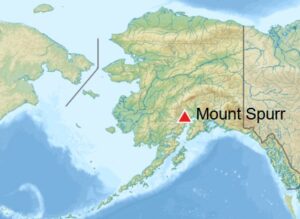
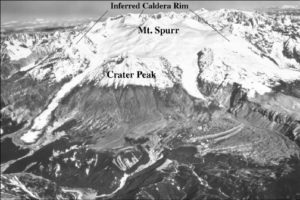 Recently, in a Mount Saint Helens-esk alert level increase, Mount Spurr, a stratovolcano in the Aleutian Arc of Alaska, made its entrance into the spotlight. The volcano isn’t about to explode in the same way Mount Saint Helens was, but it does appear to be about to erupt again. Mount Spurr was named after United States Geological Survey geologist and explorer Josiah Edward Spurr, who led an expedition to the area in 1898. Mount Spurr is currently rated at a Level of Concern Color Code Yellow by the Alaska Volcano Observatory (AVO). It’s obvious that Mount Spurr has an active history, because it is aboriginally known by the Dena’ina Athabascan name K’idazq’eni, which literally means “that which is burning inside.”
Recently, in a Mount Saint Helens-esk alert level increase, Mount Spurr, a stratovolcano in the Aleutian Arc of Alaska, made its entrance into the spotlight. The volcano isn’t about to explode in the same way Mount Saint Helens was, but it does appear to be about to erupt again. Mount Spurr was named after United States Geological Survey geologist and explorer Josiah Edward Spurr, who led an expedition to the area in 1898. Mount Spurr is currently rated at a Level of Concern Color Code Yellow by the Alaska Volcano Observatory (AVO). It’s obvious that Mount Spurr has an active history, because it is aboriginally known by the Dena’ina Athabascan name K’idazq’eni, which literally means “that which is burning inside.”
Located 81 miles west of Anchorage and northeast of Chakachamna Lake, Mount Spurr is the highest volcano of the Aleutian Arc. It has a large stratocone at the center of a roughly 3.1 miles horseshoe-shaped caldera that is open to the south. The caldera was formed by a Mount Saint Heles like “late-Pleistocene or early Holocene sector collapse and associated pyroclastic flows that destroyed an ancestral Spurr volcano. The debris avalanche traveled more than 15.5 miles to the southeast, and the resulting deposit contains blocks as large as 330 feet in diameter. Several ice-carved post-caldera domes lie in the caldera.” The present-day Mount Spurr is 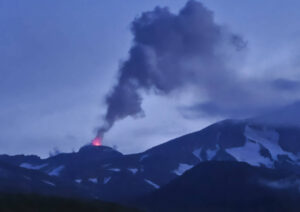 the highest of the post-caldera. So much change can take place as the events of a volcano unfold. The regrown summit peak of Mount Spurr experienced a heating event in 2004 which created a small crater lake. Then, by 2008, the summit crater had cooled enough to have begun to have accumulated significant amounts of snow again. As with any seismically active mountain, the youngest post-caldera dome, Crater Peak has grown to 7,575 feet. “It was formed at the breached southern end of the caldera about 2.0 miles south of Spurr, has been the source of about 40 identified Holocene tephra layers. Spurr’s two historical eruptions, from Crater Peak in 1953 and 1992, deposited ash on the city of Anchorage. Crater Peak has a summit crater that is itself slightly breached along the south rim; the north wall of the crater exposes the truncated remains of an older dome or lava lake. Before the 1992 eruption, a small crater lake occupied the bottom of Crater Peak’s crater.” The problem with volcanoes, especially so close to the major trans-Pacific aviation routes is that an eruption of this volcano can significantly disrupt air travel. Volcanic ash can cause jet engines to fail.
the highest of the post-caldera. So much change can take place as the events of a volcano unfold. The regrown summit peak of Mount Spurr experienced a heating event in 2004 which created a small crater lake. Then, by 2008, the summit crater had cooled enough to have begun to have accumulated significant amounts of snow again. As with any seismically active mountain, the youngest post-caldera dome, Crater Peak has grown to 7,575 feet. “It was formed at the breached southern end of the caldera about 2.0 miles south of Spurr, has been the source of about 40 identified Holocene tephra layers. Spurr’s two historical eruptions, from Crater Peak in 1953 and 1992, deposited ash on the city of Anchorage. Crater Peak has a summit crater that is itself slightly breached along the south rim; the north wall of the crater exposes the truncated remains of an older dome or lava lake. Before the 1992 eruption, a small crater lake occupied the bottom of Crater Peak’s crater.” The problem with volcanoes, especially so close to the major trans-Pacific aviation routes is that an eruption of this volcano can significantly disrupt air travel. Volcanic ash can cause jet engines to fail.
On July 26, 2004, the AVO raised the “Color Concern Code” at Spurr from green to yellow due to an increasing number of earthquakes. When it comes to volcanoes, earthquakes beneath the surface may indicate the movement of magma preceding a volcanic eruption. Of course, the earthquakes might also die out without an eruption. In the first week of August 2004, the AVO reported the presence of a collapse pit, filled with water forming a new crater lake, in the ice and snow cover on the summit. It is thought that this lake might have been caused by an increase in heat flow through the summit lava dome. A debris flow was observed in webcam 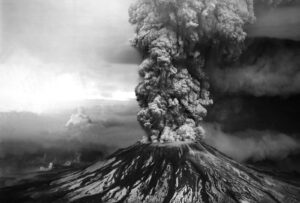
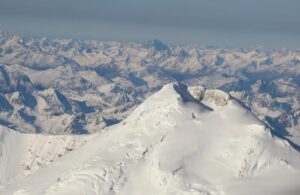 images, as well as by a nearby pilot on May 3, 2005. A subsequent overflight revealed that much of the sitting pond within the melt hole had drained away, leaving a cauldron of notable depth. On October 23, 2024, the alert level for Mount Spurr was again raised to yellow (advisory), because of an increase in seismic activity, which is what reminds me of the Mount Saint Helens alerts.
images, as well as by a nearby pilot on May 3, 2005. A subsequent overflight revealed that much of the sitting pond within the melt hole had drained away, leaving a cauldron of notable depth. On October 23, 2024, the alert level for Mount Spurr was again raised to yellow (advisory), because of an increase in seismic activity, which is what reminds me of the Mount Saint Helens alerts.


Leave a Reply